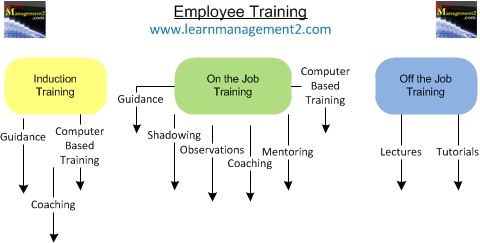Employee Training
Introduction
Training employees is an essential activity for all organisations. Training provides employees with the knowledge and skills they need to perform their job.
Benefits Of Training
- As the business world is continuously changing, organisations will need to provide their employees with training throughout their careers. If they choose not to provide continuous training they will find it difficult to stay ahead of the competition.
- The other benefit of training is that it will keep your employees motivated. New skills and knowledge can help to reduce boredom. It also demonstrates to the employee that they are valuable enough for the employer to invest in them and their development.
- Training can be used to create positive attitudes through clarifying the behaviours and attitudes that are expected from the employee.
- Training can be cost effective, as it is cheaper to train existing employees compared to recruiting new employee with the skills you need.
- Training can save the organisation money if the training helps the employee to become more efficient.
Induction Training
This is training that an employee will receive when they first join an organisation or begin a new role. This type of training is designed to provide the employee with the essential skills needed to perform their job. Induction training can also include an introduction to the company ethos, values and culture so that the employee is aware of the behaviours expected of them.
On the Job Training
As the name suggests, on the job training, is training provided during the regular performance of duties. This can take a variety of forms including
Guidance
The employee being guided through a task or process by a colleague or supervisor, so that the employee knows how to perform the task and to what standard.
Shadowing
Spending time with an expert so that the employee can observe how the expert performs their daily duties.
Observations
The employee is observed whilst they perform their duties. At the end of the observation, the observer will provide the employee with feedback on their performance and a training plan based on the results from the observation.
Coaching
The idea behind coaching is to improve the employee's existing skills, (or to provide them with new skills) by focusing on how the employee performs something i.e. there is a focus on technique. Coaching provides employees with the opportunity to practice skills with a coach away from their usual work environment.
Mentoring
The employee is partnered with an experienced employee so that they can discuss performance. The experienced person is known as the mentor and the employee they are partnered with we will call the mentoree. The mentoree will discuss their performance and problems with the mentor.
Computer Based Training
Some firms will use a computer based (digital app) to provide training. Computer based training usually involves providing the employee with relevant information followed by quizzes to test how well the employee has learnt the information.
Off the Job Training
This is training provided away from the employee’s usual work environment. Off the job training may be in the same building or off site. This training may be provided by trainers working for the same employer as the employees being trained or an outside company hired by the employer. Off the job training is often used to support the employees studying for a formal qualification or exam. In contrast to coaching this type of training usually focuses on knowledge and not skills.
Conclusion
Continuous employee training is essential as it ensures your employees always have the knowledge and skills to work effectively. In fact some professions such as medicine and law stipulate that practitioners have to perform a minimum number of continuous professional development.
